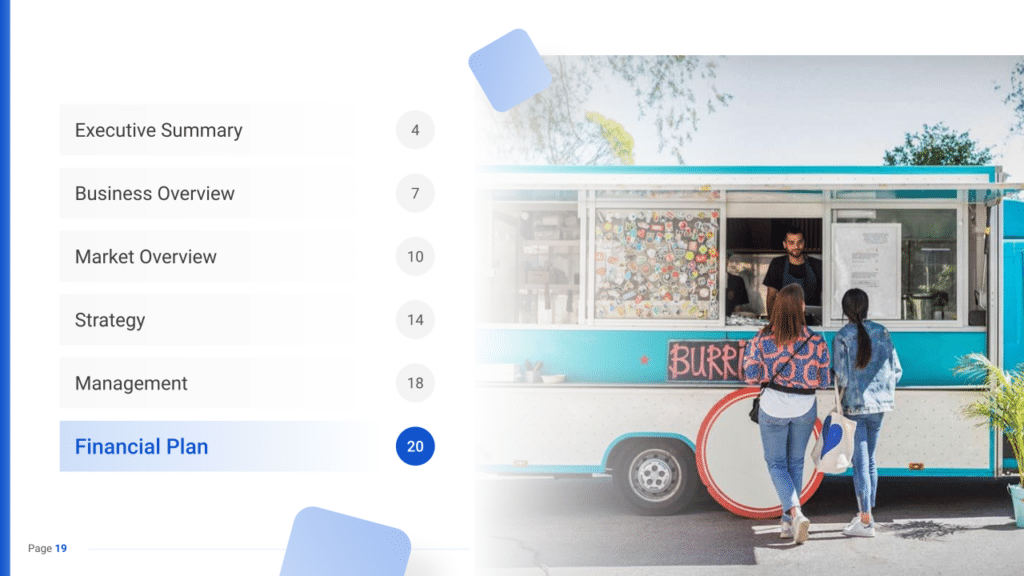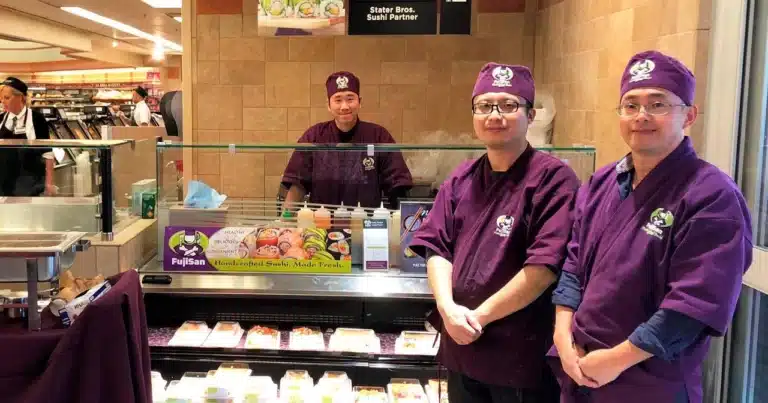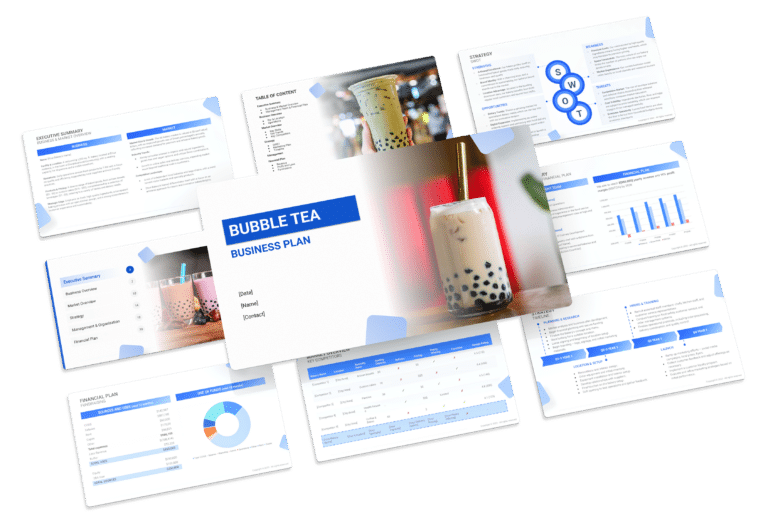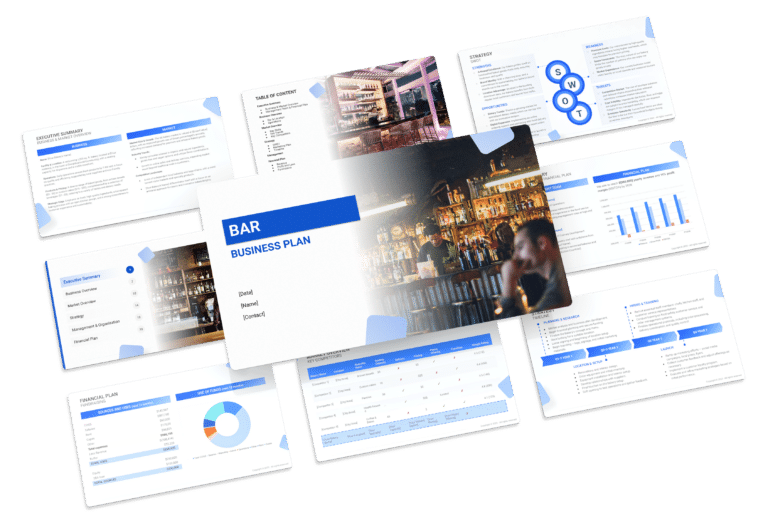Food Truck Business Plan Template & PDF Example
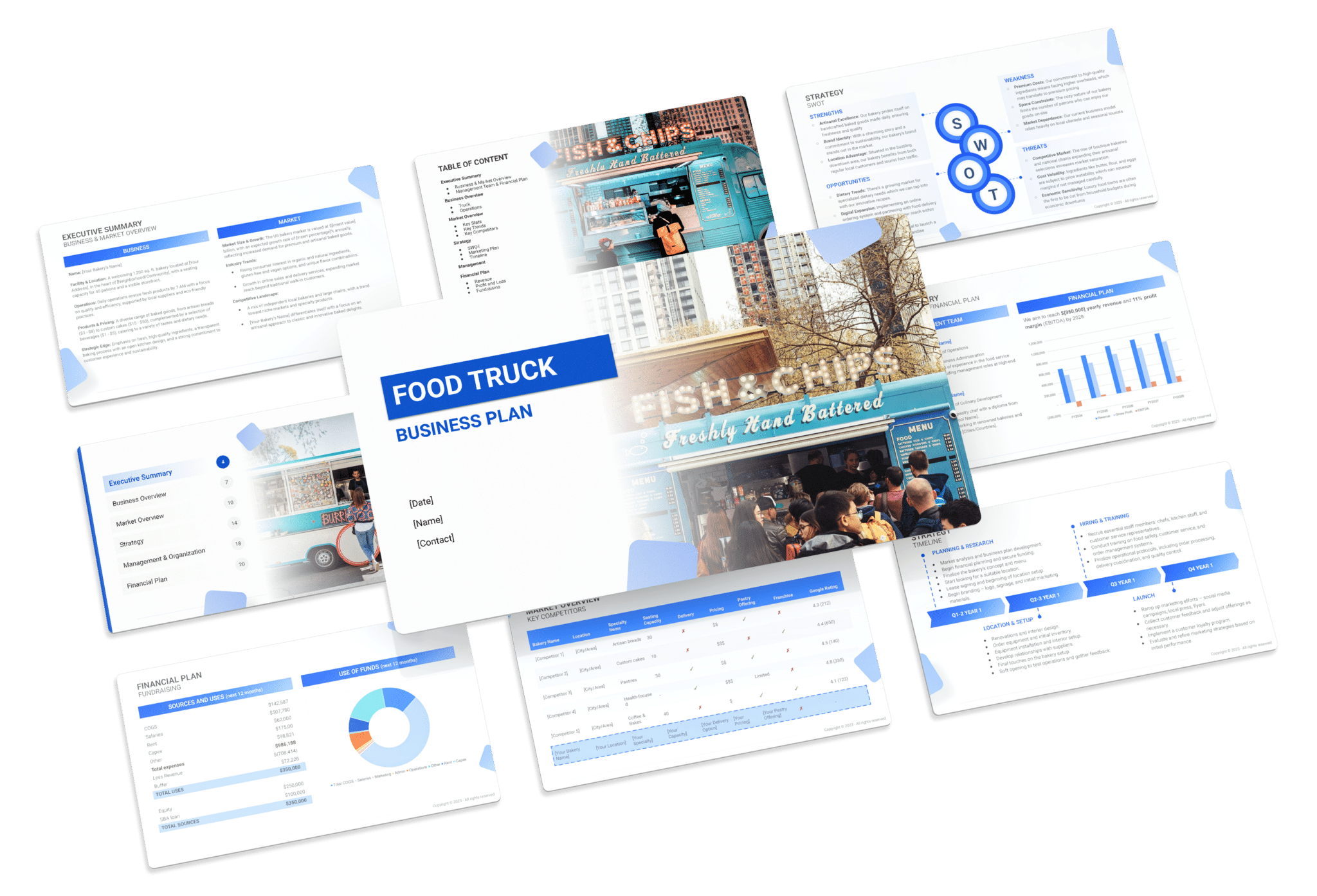
Creating a comprehensive business plan is crucial for launching and running a successful food truck. This plan serves as your roadmap, detailing your vision, operational strategies, and financial plan. It helps establish your food truck’s identity, navigate the competitive market, and secure funding for growth.
This article not only breaks down the critical components of a food truck business plan, but also provides an example of a business plan to help you craft your own.
Whether you’re an experienced entrepreneur or new to the food&beverages industry, this guide, complete with a business plan example, lays the groundwork for turning your food truck concept into reality. Let’s dive in!
The Plan
Our food truck business plan is designed to address all crucial elements for a holistic strategy. It specifies the truck’s operations, marketing tactics, market context, competition, management organization, and financial projections.
- Executive Summary: Offers an overview of your Food Truck’s business concept, including the unique cuisine offered, market analysis, the management team’s expertise, and the financial strategy to ensure profitability and growth.
- Business Overview: Provides detailed information on what your Food Truck offers and its operational model:
- Food Truck & Location: Describes the food truck’s design, mobility advantages, and strategic locations where it will operate to maximize customer reach and sales.
- Menu & Pricing: Lists the culinary offerings of your Food Truck, including signature dishes, pricing structure, and how these align with customer preferences and market demand.
- Market Overview: Examines the food industry landscape, focusing on the food truck sector, identifying competitors, and how your truck stands out:
- Key Stats: Shares industry size, growth trends, and relevant statistics for the food truck market, underscoring the opportunity your business aims to capture.
- Key Trends: Highlights recent trends in the food truck industry, such as the popularity of ethnic cuisines, health-conscious menus, and the use of technology for ordering and payments.
- Key Competitors: Analyzes main competitors within your operating regions and how your Food Truck offers a unique dining experience that differentiates it from the rest.
- Strategy: Outlines how the Food Truck intends to achieve growth and attract clients:
- SWOT: Strengths, weaknesses, opportunities, and threats analysis, providing insights into your business’s competitive position and strategic opportunities.
- Marketing Plan: Strategies for attracting and retaining customers, including social media engagement, participation in local events, and promotional campaigns.
- Timeline: Key milestones and objectives from start-up through the first year of operation, including the launch strategy, menu expansion, and customer engagement initiatives.
- Management: Information on who manages the Food Truck, their roles, culinary expertise, and experience in the food and beverage industry, emphasizing the team’s capability to execute the business plan effectively.
- Financial Plan: Projects the Food Truck’s financial performance over the next 5 years, including revenue projections, cost management strategies, and profit margin goals. This section will detail start-up costs, ongoing operational expenses, and revenue projections based on estimated foot traffic and average customer spend.

Executive Summary
The Executive Summary presents an overview of your Food Truck business, encapsulating the essence of your mobile dining experience. It should highlight your market positioning, the variety of culinary offerings you provide, its operational zones, size, and a snapshot of day-to-day operations.
This section should further delve into how your Food Truck will seamlessly integrate into the local culinary scene, including an analysis of direct competitors within the region, identifying who they are, coupled with your Food Truck’s unique selling propositions that set it apart from these competitors.
Additionally, details regarding the management and co-founding team should be included, outlining their roles and contributions to the Food Truck’s success. A summary of your financial projections, including anticipated revenue and profits over the next five years, should also be included to offer a comprehensive view of your Food Truck’s financial strategy.
Food Truck Business Plan Executive Summary Example
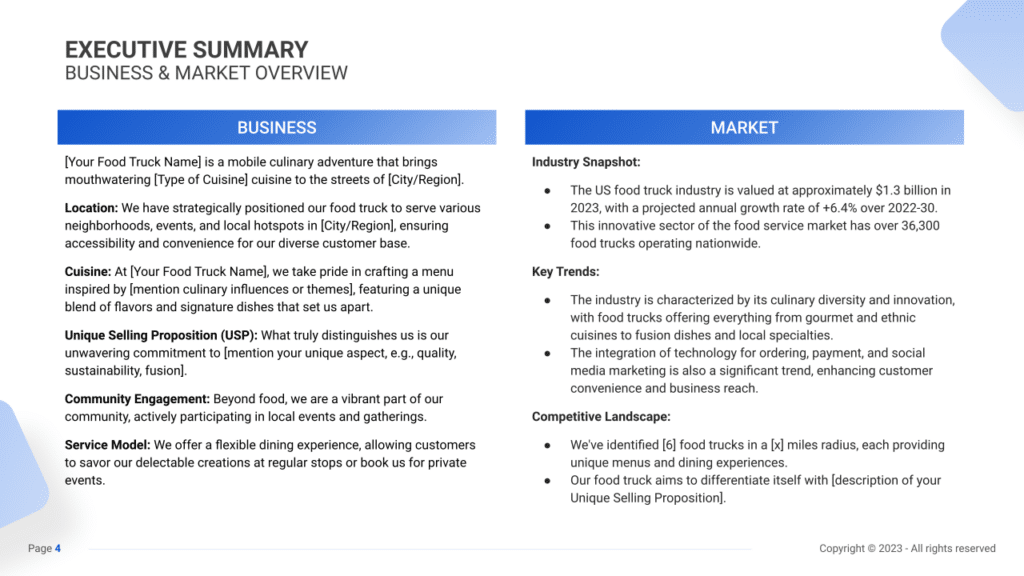
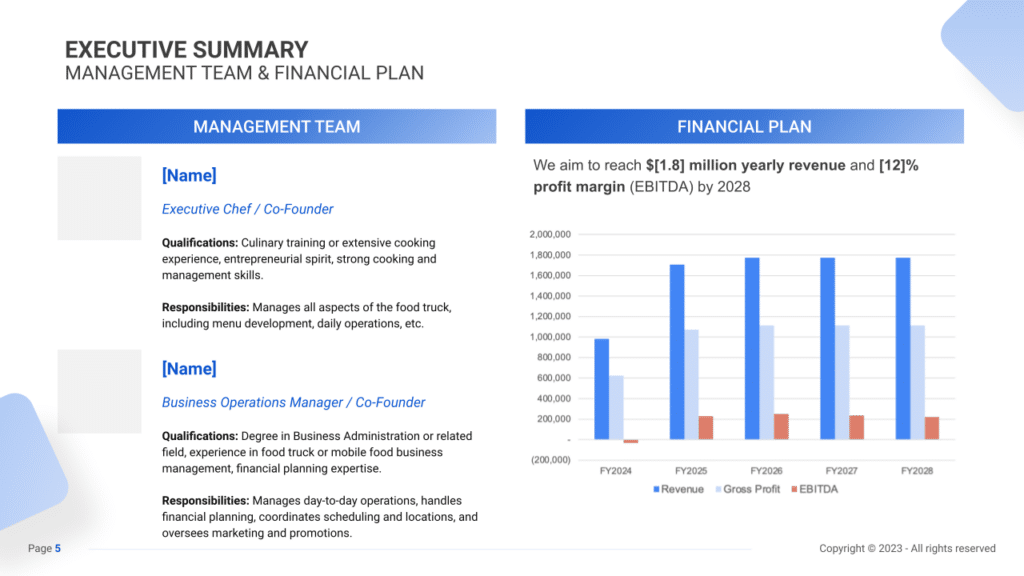
Business Overview
A concise overview introduces essential details like the truck’s name, mobility aspects, culinary specialties, and a snapshot of its community involvement.
These details set the stage for your food truck, framing its unique characteristics. A unique selling proposition (USP) distinguishes your truck. Whether it’s a focus on high-quality ingredients, a sustainable approach, or a fusion of culinary influences, highlight this USP in your executive summary to showcase your truck’s distinctive value proposition.
Example:
“FlavorWheels Food Truck” is a mobile culinary adventure bringing mouthwatering fusion cuisine inspired by global flavors to the streets of Metroopolis. Strategically positioned across diverse neighborhoods and local events, our truck offers an array of signature dishes that blend culinary influences to provide a unique dining experience. Our unwavering commitment to sourcing fresh, local ingredients distinguishes us in the mobile food scene, while our active participation in community events fosters our connection with customers beyond food.
Market Overview
Understanding market dynamics and your position within it is crucial. This section should underscore the potential of the local food truck scene, supported by relevant data such as consumer demand trends and market growth rates. Discussing trends, such as the increasing popularity of diverse cuisines and the rise in community-focused dining experiences, illuminates your truck’s positioning within the evolving landscape.
Additionally, highlight the flexibility and convenience your food truck offers. Whether catering to regular stops or private events, emphasize your truck’s adaptability to meet varied customer preferences.
Example:
In the local food truck scene of Metropolis, valued at $3 million annually with a 15% growth rate, FlavorWheels Food Truck leads with its unique fusion cuisine and active community engagement. Amidst competition, our commitment to quality ingredients and a mobile service model that caters to diverse customer preferences positions us as a sought-after choice for food enthusiasts seeking a flavorful culinary journey on wheels.
Management Team
Highlight the expertise and background of your management team, showcasing their capabilities in driving truck success.
This could include your culinary expert’s culinary training or extensive cooking experience, your operations manager’s background in business administration, or expertise in food truck management. Demonstrating the team’s competency builds credibility and assures potential investors and partners of your truck’s potential for success.
Example:
At FlavorWheels Food Truck, Chef Michelle Davis, with extensive culinary training and a passion for creative cooking, manages all aspects of the truck, from menu development to daily operations. Supported by an operations manager, John Reynolds, with a degree in Business Administration and expertise in food truck business management, the truck maintains a focus on delivering exceptional culinary experiences and efficient operations.
Financial Plan
Provide an overview of your financial goals and projections, offering insights into revenue targets, profit margins, and anticipated growth trajectories.
Example:
FlavorWheels Food Truck aims for a projected revenue of $1.8 million annually, targeting a 12% EBITDA profit margin by 2028. Investment in high-quality ingredients, operational efficiency, and strategic marketing initiatives geared towards food enthusiasts on the move drive anticipated growth and profitability within the local food truck market.
Business Overview
For a Food Truck, the Business Overview section can be effectively organized into 2 main categories:
Food Truck & Location
Provide a vivid description of your Food Truck’s design, emphasizing its unique, inviting appearance and the efficient layout that ensures a smooth service flow. Highlight the mobility of your Food Truck, allowing it to operate in various prime locations, enhancing accessibility to a broader clientele.
Mention specific spots where the truck will be stationed, such as near business districts, parks, or during special events, and explain why these locations are strategically chosen to attract your target market.
Menu & Pricing
Elaborate on the culinary offerings of your Food Truck, showcasing a diverse menu that caters to a wide range of tastes and dietary preferences. Whether it’s gourmet sandwiches, ethnic cuisines, vegan options, or specialty beverages, ensure your menu reflects the unique theme and concept of your Food Truck.
Discuss your pricing model, ensuring it’s competitive yet fair, reflecting the quality and uniqueness of your dishes. Highlight any special deals, combo offers, or loyalty incentives designed to enhance customer value and foster repeat business and loyalty among your patrons.

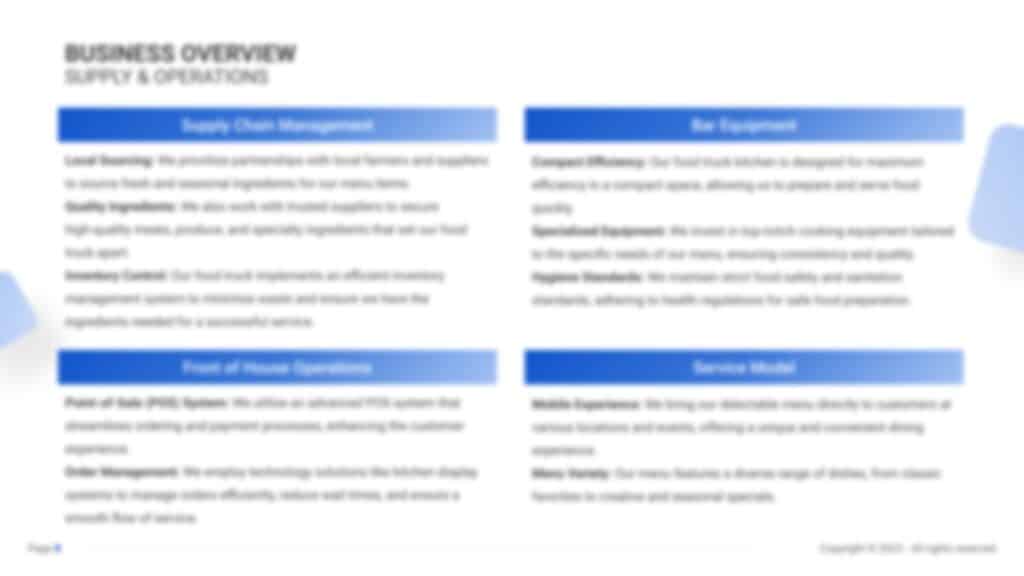
Market Overview
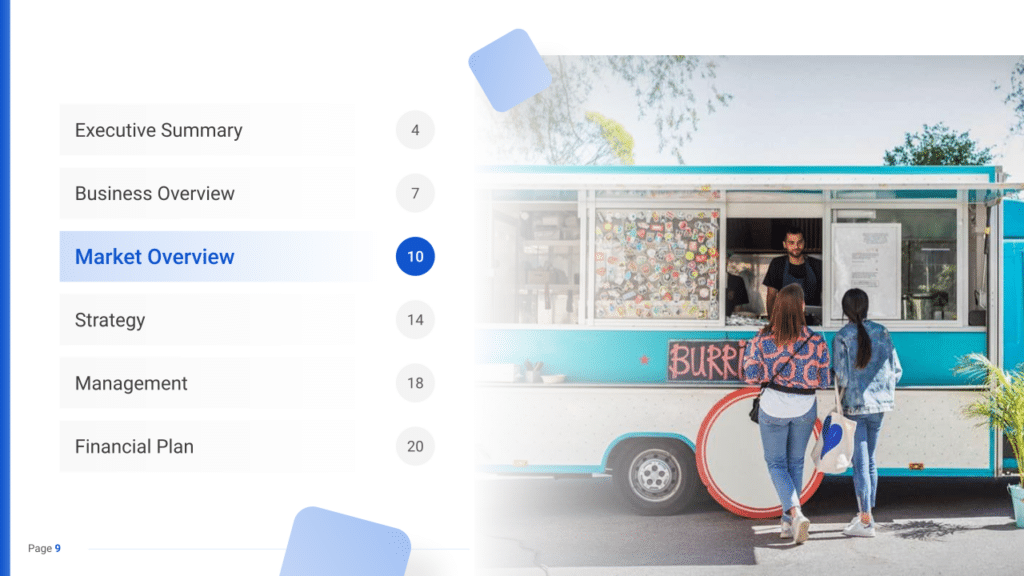
Industry Size & Growth
In the Market Overview of your Food Truck business plan, begin by exploring the size of the food truck industry and its potential for growth. This analysis is essential to grasp the market’s breadth and to pinpoint opportunities for expansion. The food truck sector has been on a steady rise, fueled by changing consumer dining habits and the demand for high-quality, convenient, and diverse food options available at various locations.
Key Market Trends
Continue by delving into prevailing market trends, such as the growing consumer preference for street food that offers a gourmet dining experience, the surge in demand for international and fusion cuisines, and the emphasis on locally sourced and sustainable ingredients.
Highlight how these trends align with your Food Truck’s offerings, whether it’s through a menu that caters to niche culinary preferences, the integration of healthy and organic options, or the adoption of eco-friendly practices.
Competitive Landscape
A competitive analysis is not just a tool for gauging the position of your food truck in the market and its key competitors; it’s also a fundamental component of your business plan. This analysis helps in identifying your food truck’s unique selling points, essential for differentiating your business in a competitive market.
In addition, the competitive analysis is integral in laying a solid foundation for your business plan. By examining various operational aspects of your competitors, you gain valuable information that ensures your business plan is robust, informed, and tailored to succeed in the current market environment.
Identifying Competitors in the Food Truck Scene
The initial phase involves identifying the spectrum of competitors operating within your food truck’s vicinity. Begin by scouting local food truck parks, popular street food areas, and events where food trucks frequently gather. Your direct competitors could range from other food trucks serving similar cuisines to nearby fast-casual restaurants and eateries offering similar menu items.
Leverage digital tools like Google Maps and social media platforms to map out competitor locations. Online reviews on platforms like Yelp or food-specific apps often contain insightful customer feedback highlighting competitors’ strengths and weaknesses. For instance, positive reviews commending the mouthwatering tacos at “Taco Haven” spotlight a competitor’s distinct offering.

Food Truck Competitor’s Strategies
Analyzing the strategies employed by these competitors involves multifaceted considerations:
- Menu Offerings: Scrutinize the diversity and uniqueness of their menu offerings. If “Healthy Bites on Wheels” is gaining traction with its emphasis on organic, locally sourced ingredients, it signifies a trend toward health-conscious street food options.
- Culinary Approach: Consider the cooking techniques and culinary styles embraced by competitors. A food truck like “Retro Eats,” specializing in nostalgic comfort food, may attract a different clientele compared to “Fusion Flavors,” renowned for blending international tastes into their dishes.
- Pricing Tactics: Compare your pricing strategy with competitors. Are your menu prices aligned with more budget-friendly options like “Quick Bites Truck” or closer to premium offerings like those from “Gourmet Wheels”?
- Marketing Initiatives: Evaluate how competitors promote their food. Do they leverage social media platforms extensively, or do they rely on location-based marketing and word-of-mouth referrals?
- Customer Engagement: Assess the overall customer experience. For example, “Friendly Feasts Truck” might be recognized for its personalized service and engaging interactions, enhancing the overall dining experience.
- Operational Innovations: Observe if competitors incorporate technological advancements or innovative processes in food preparation and service, such as “Efficient Eats on Wheels” utilizing a mobile app for pre-orders and quick pickups.
What’s Your Food Truck’s Value Proposition?
Delve into your food truck’s unique value proposition. Perhaps your truck is celebrated for its specialty gourmet burgers, or it offers a fusion of lesser-known international street foods not easily found elsewhere.
Identify gaps in the market through customer feedback and emerging food trends. For instance, if there’s a growing interest in plant-based street food options and competitors are yet to tap into this segment, it could present an opportunity for your food truck.
Consider your locations carefully. A food truck stationed near office districts might focus on offering quick and convenient lunch options, while one positioned at local events or festivals might emphasize diversity and cater to varied tastes.
Strategy
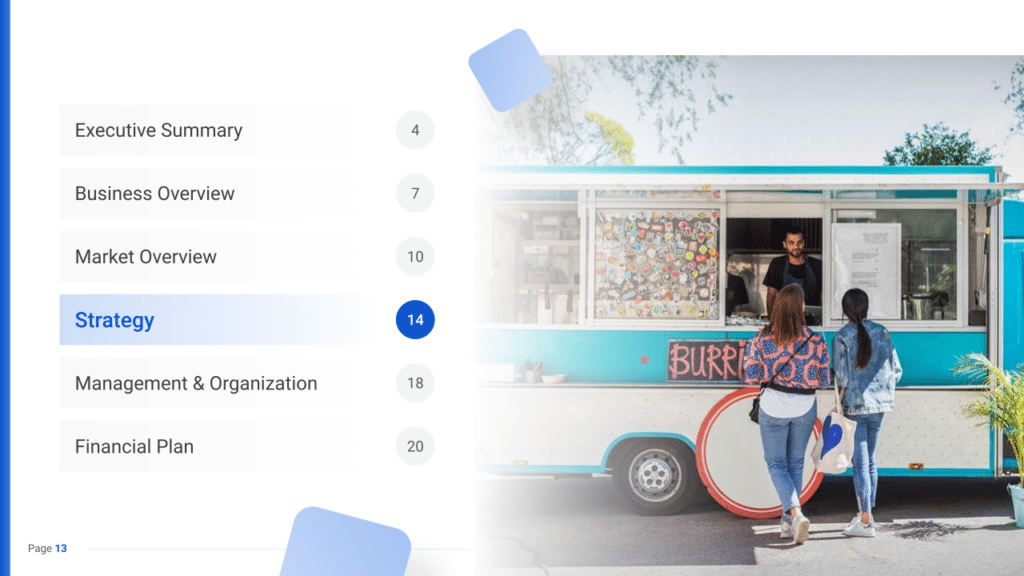
SWOT
First, conduct a SWOT analysis for the Food Truck, highlighting Strengths such as an innovative menu and strong brand, Weaknesses including limited operational space and regulatory complexities, Opportunities like tapping into emerging food trends and leveraging strategic locations, and Threats from increased competition and economic factors.

Marketing Plan
Next, develop a marketing strategy that outlines how to attract and retain customers through targeted advertising, promotional discounts, engaging social media presence, and community involvement.
Marketing Channels
Utilize diverse marketing channels to augment brand awareness and engage potential customers.
Digital Marketing
- Social Media: Utilize platforms like Instagram, Facebook, and Twitter to showcase your delectable dishes, share engaging content, and announce your truck’s schedule and locations.
- Website and SEO: Develop an intuitive website with menu details, a schedule, and location tracking. Optimize it for local SEO to enhance visibility in search results.
- Email Marketing: Developing an email list is essential for nurturing customer relationships and driving repeat business. Encourage visitors to your food truck to subscribe to your mailing list by offering exclusive deals or a first-time purchase discount. Utilize sign-up forms on your website and at your truck’s location to gather email addresses.
Local Advertising
- Flyers and Community Outreach: Distribute flyers at local events and collaborate with nearby businesses for promotional activities.
- Events and Collaborations: Participate in food festivals and markets, or partner with local entities for joint events to broaden your audience.
Promotional Activities
Engage potential customers with appealing offers and loyalty programs.
Special Deals
- Seasonal Promotions: Introduce themed promotions or limited-time discounts during festivals or holidays.
- First-Time Visitor Offers: Attract new customers by offering exclusive discounts or freebies for their first purchase.
Loyalty Programs
- Loyalty Cards or Apps: Implementing a loyalty program rewards frequent customers with discounts, free meals, or exclusive perks. Encouraging repeat business through loyalty programs fosters a sense of appreciation and incentivizes customers to choose your truck over competitors.
- Referral Rewards: Motivate existing customers to refer friends and family by offering incentives like discounts on future orders, freebies, or bonus loyalty points. Word-of-mouth recommendations are powerful in attracting new clientele.

Sales Channels
Maximize revenue streams and provide added value to customers.
Service Enhancements
- Upselling: Offer additional toppings, combos, or limited-time specials to increase the average order value.
- Limited-time Offers: Create a sense of urgency by introducing exclusive chef specials or seasonal menu items.
Online Sales and Convenience
- Online Ordering: Implement a convenient online ordering system through your website or app.
- Merchandise Sales: Sell branded merchandise or related products through your website or at the truck.
Membership and Loyalty Programs
- Membership Options: Creating membership programs offering monthly service packages, exclusive access to new menu items, or special events can encourage customers to commit to regular patronage.
- Loyalty Rewards: Developing digital loyalty programs where customers earn points for every purchase, redeemable for discounts or free items, ensures continued engagement and loyalty.
Strategy Timeline
Finally, create a detailed timeline that outlines critical milestones for the Food Truck’s opening, marketing efforts, customer base growth, and expansion objectives, ensuring the business moves forward with clear direction and purpose.

Management
The Management section focuses on the food truck’s management and their direct roles in daily operations and strategic direction. This part is crucial for understanding who is responsible for making key decisions and driving the food truck towards its financial and operational goals.
For your food truck business plan, list the core team members, their specific responsibilities, and how their expertise supports the business.
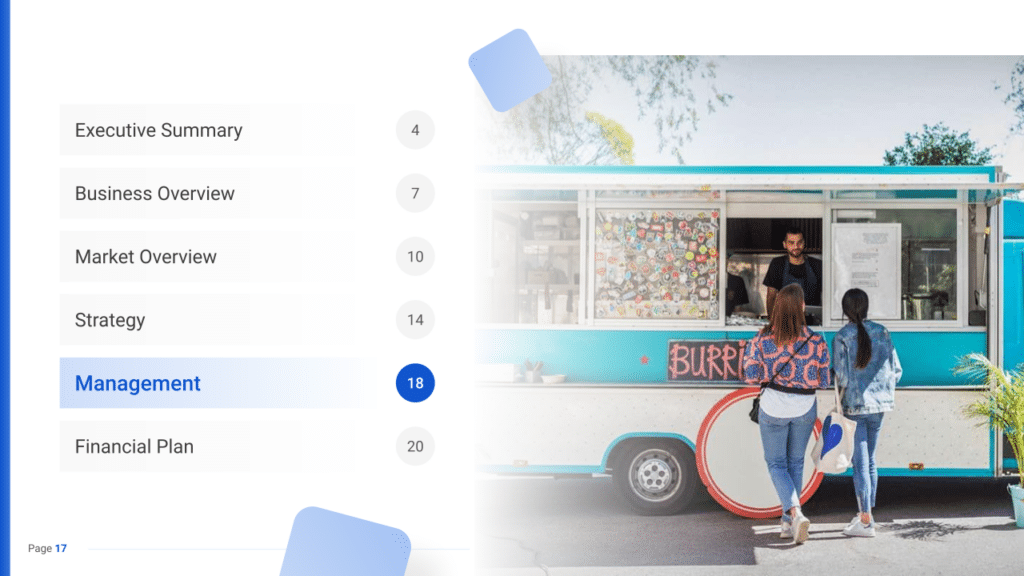

Financial Plan
The Financial Plan section is a comprehensive analysis of your financial projections for revenue, expenses, and profitability. It lays out your food truck’s approach to securing funding, managing cash flow, and achieving breakeven.
This section typically includes detailed forecasts for the first 5 years of operation, highlighting expected revenue, operating costs and capital expenditures.
For your food truck business plan, provide a snapshot of your financial statement (profit and loss, balance sheet, cash flow statement), as well as your key assumptions (e.g. number of customers and prices, expenses, etc.).
Make sure to cover here
_ Profit and Loss
_ Cash Flow Statement
_ Balance Sheet
_ Use of Funds
